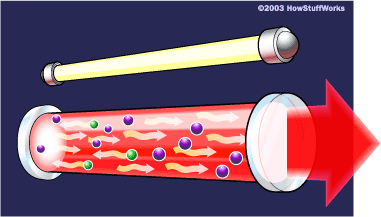LASERS:
GOING
VEEERRRYYYY SLLLOOOWWWLLYYYYY
Any good fiction needs conflict, and what better conflict
than war! But with war, comes weapons. Thankfully, our science fiction
writes have brought us into the future with the invention of lasers as
a means of giant, wonderful, fiery explosions. Unfortunately, some of
them go about it completely wrong.
The idea behind a laser begins with atoms themselves. In
most cases, atoms are surrounded by electrons, and these electrons
orbit atoms at specific orbitals. Each electron can enter higher states
of energy whenever energy is added to the electron. The electrons are
then considered to be in an “excited” state.
An atom.
Once they come back down to their original state after
being in an excited one, they emit a photon. Most of the time, these
photons are emitted in a somewhat random direction. A flashlight, for
example, has photons going in random directions, so that in a sense
they are unorganized. If those photons are bounced back and forth until
they are in a line between two mirrors, the photons line up and are
“organized.”

Line them up and watch them go! An "organized" stream of electrons.
That is an extremely simplified version of what actually
happens in a laser. Using excited electrons to emit photons, and then
making each of those photons move back and forth in an organized
pattern creates the beam we know so well in science fiction. But in
order for us to do any damage with these beams, they need to be at
extremely high power when emitted.
Now, as for relevance, Star Wars is the easiest
comparison. Pick any fight scene in any of the movies that involves
either a laser gun or a light-saber. If we assume that these weapons
are in fact lasers, and not some extremely odd electron-photon magic,
none of them should work, or at least appear to work as they do.

Slowest moving lasers EVER.
The
first example has to do with the way we see the lasers. In Star Wars,
lasers are “shot” in short bursts that we can see as short beams that
fly through space. Unfortunately, the only way for this to happen is to
disregard one of the most basic concepts of physics itself: the speed
of light, which in a vacuum is 299,792,458 meters per second. The only
way for our eyes to see the lasers in Star Wars is if you were to slow
light down enough to make it travel through space MUCH slower than it
actually travels.
Our
other example is even more physics breaking. The light saber, a weapon
that arguably defines the Star Wars universe, asserts that a small hand
held device can emit a laser that not only stops at a certain distance
and continues to maintain its shape, but also has the ability to
deflect other lasers that have been already shown to be against the
laws of physics in the paragraph above.

Darth Vader, just ignoring the breaking of physics.
First, in order for a laser to “stop”, it must be reflected back to
the source or be absorbed completely. This requires something
physically
at the endpoint of the laser that has the capability to reflect the
photons back, such as a mirror. Even if that were possible, there would
have to be some way to reflect the laser again to keep it from tearing
apart the emission device.
This also comes into play when deflecting lasers, as shown in the Star
Wars films. Even if it were possible to slow down the photons from a
laser in the way we see them in the films, there would still need to be
some sort of reflective surface (black holes aside) to be able to make
them change their direction.
With all this said, many come up with other arguments to allow for the
light saber to work. First, some argue that the photons from a laser
don't necessarily need to be "reflected" if they can be bent. If we
assume that a light saber has the technology to actually bend photons
back to create an ellipse, thus showing that the light never actually
stops and does not need to be reflected, then the light saber can have
a working model.
Another argument is that the light saber isn't actually light, it's a
plasma. We use plasma cutters today, and they have been shown to work.
The biggest problem the plasma theory has is the supply of power and
fuel. Plasma cutters rely on a gas, such as nitrogen or oxygen, to be
superheated to a point where it becomes a plasma. In order for a plasma
saber to work, we first need the power required to superheat the gas to
a plasma, then have a seemingly unlimited gas supply, all packed into a
hand held device.
Thomas
Edwards
- Physics 211x - FH1 - 2010




